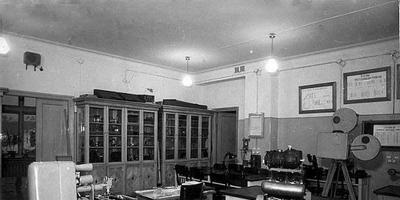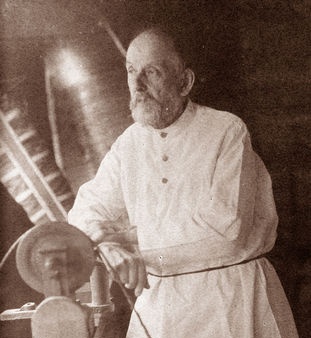|
 If each cell of the Mendeleev table is compared with an island, then this one is like an archipelago. Its owner - lanthanum - had to make room. Fifteen elements were "squeezed" into his apartment ... However, this is not a whim of the chemist. Nature is to blame. If each cell of the Mendeleev table is compared with an island, then this one is like an archipelago. Its owner - lanthanum - had to make room. Fifteen elements were "squeezed" into his apartment ... However, this is not a whim of the chemist. Nature is to blame.
It was she who gave fifteen elements exactly the same outer electron shells and, as a consequence, the same chemical properties. Therefore, breaking the tight embrace of the twins was not easy. True, some of them were obtained in a fairly pure form back in the last century, but chemists did not find any particularly useful properties then in their grains. The game was clearly not worth the candle, and fifteen rare earth elements for a long time left the sphere of active attention of scientists.
The second half of the 20th century has come - a time of unprecedented rapid development of science and technology. Then they "remembered" the fifteen twins. However, by this time two more had joined their "creative association". Although yttrium and scandium occupied separate cells of the Mendeleev table, they were also attributed to the rare earth family. There was a good reason for this - the commonality of properties.
From the height of the flying plane, the herd of horses looks like a solid dark cloud. Rare earth elements, too, only "from a distance" seemed the same. Each of them has its own, special character. It turned out that neodymium hardens light magnesium alloys well. Cerium, absorbing various impurities contained in the dissolved metal, makes the ingots more monolithic, and parts made of them more reliable. But especially yttrium distinguished itself. One percent of this metal was added to stainless steel, and its oxidation temperature jumped sharply from 1093 to 1370 degrees. Yttrium also improves the properties of chromium. In addition, five more rare earth elements have a beneficial effect on chromium: praseodymium, neodymium, gadolinium, erbium, and lutetium. New magnetic alloys have been created using dysprosium. The remarkable magnetic properties of many of these elements are of exceptional scientific interest.
Rare earth metals are also used in nuclear technology. Various materials of construction with cerium and neodymium have proven to be very useful for nuclear reactors. Physicists greeted enthusiastically with gadolinium, europium, samarium, dysprosium, which have the ability to absorb thermal neutrons with extraordinary activity. From the metals of this remarkable "quartet" and their compounds, rods for control and emergency protection of nuclear reactors are made.
Radioactive rare-earth isotopes also do useful work. One of the promethium isotopes turned out to be especially interesting. Its half-life is 2.6 years. It emits radiation that is very easy to protect against. Naturally, such an isotope could not fail to interest scientists. On its basis, miniature and subminiature atomic batteries began to be manufactured. The diameter of such a battery is about a dime. It can be slipped into a ring or cufflink. Even at temperatures of about one hundred degrees (plus or minus), a promethium battery lasts for almost five years. It can power a miniature radio or hearing aid.
Other radioactive rare-earth isotopes - thulium, yttrium, europium - have already found applications in medicine. X-ray scanning apparatus with thulium isotope as a source of penetrating rays is extremely simple and small. It does not need power supply and weighs only a few kilograms. Imagine how convenient it is where there is no electricity yet!
An interesting discovery with the help of the radioactive isotope thulium was made by English archaeologists. They found a bronze Assyrian helmet from the 9th century BC. It was decided to investigate it X-ray.But the helmet had a hemispherical shape, and it turned out to be impossible to use a conventional X-ray apparatus. Then a thulium preparation was injected inside the helmet, and a film was placed outside. When the film was developed, it clearly showed ancient writing and symbolic signs, erased by time. Rare earth elements have helped historians.
 |
| Academician D. N. Pryanishnikov |
Probably, the salts of rare earths will turn out to be wonderful micronutrients. On soil containing such salts, the yield of some crops was much higher than on ordinary ones. It is not without reason that Academician D.N.Pryanishnikov pointed out that the rare earths contained in the Khibiny apatites have a fruitful effect on the development of plants.
Rare earths are working wonders in the glass industry. Thanks to the addition of cerium, glasses acquire the ability to trap radioactive radiation. Observation windows of nuclear reactors are made of such glasses. Cerium is one of the best materials for glass decolorization. But his other colleagues - neodymium and praseodymium - paint the glass in different colors, giving them amazingly beautiful pale purple, green and other shades. A mixture of neodymium and praseodymium creates the so-called alexandrite effect: glasses with these metals change color depending on whether the lighting is daytime or evening. A special class of lanthanum glasses has also been created for the most complex optical devices.
Rare earth elements and their compounds are also used in ceramics, refractories, radio engineering, radio electronics, lighting engineering and many other branches of the latest technology.
Ten years ago, a story about the use of lanthanum and its family could fit into a small page. Today, a large article is not enough for this.
Of course, not all the secrets of rare earths have already been revealed. In their archipelago today there are islands that, one might say, no man's foot has stepped on - elements that have not yet been even obtained in pure form in sufficiently large quantities ...
Gavrilova N.V.
|
 If each cell of the Mendeleev table is compared with an island, then this one is like an archipelago. Its owner - lanthanum - had to make room. Fifteen elements were "squeezed" into his apartment ... However, this is not a whim of the chemist. Nature is to blame.
If each cell of the Mendeleev table is compared with an island, then this one is like an archipelago. Its owner - lanthanum - had to make room. Fifteen elements were "squeezed" into his apartment ... However, this is not a whim of the chemist. Nature is to blame.








